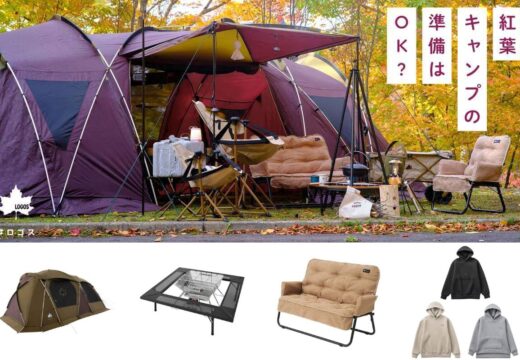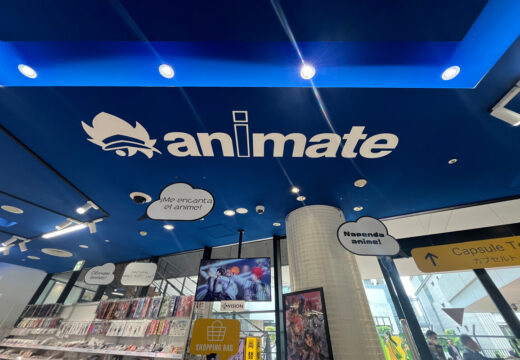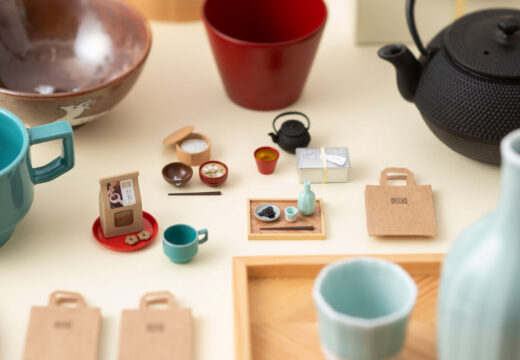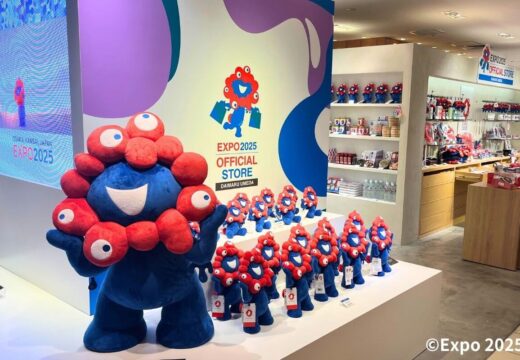See, touch and experience traditional Japanese crafts at Expo 2025 Osaka, Kansai
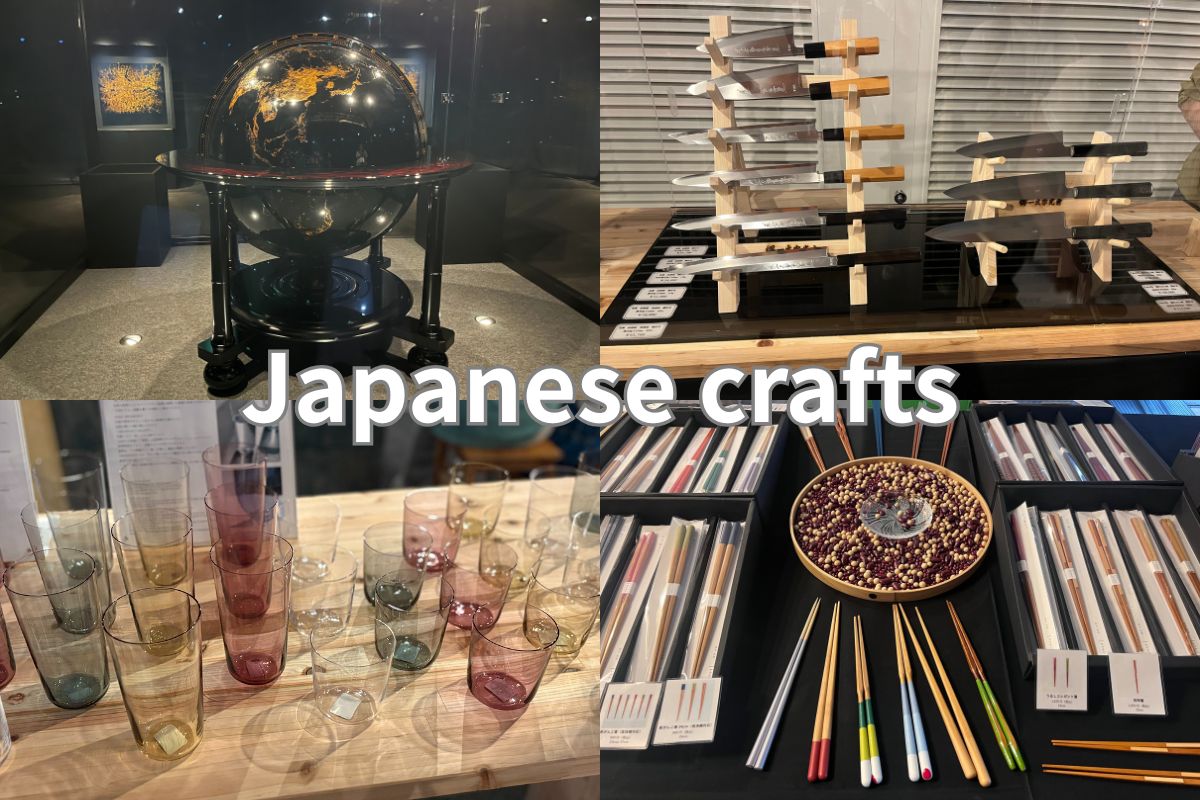
Hello, this is Hakoboya, the souvenir advertising captain for Kodawari Times. This summer in Japan is hot again! Despite the scorching heat, the big event being held in Osaka is Expo 2025 Osaka, Kansai. Has anyone been there yet?
Not only can you learn about cultures, history, and technology from around the world, but you can also enjoy Japanese culture and performing arts all at once. Among these, Kodawari Times is focusing on the “Kodawari (particular)” local products that are produced all over Japan! This time, I’d like to introduce some of the traditional Japanese crafts that I encountered at Expo 2025 Osaka, Kansai.
Expo and the History of Crafts
First, let’s talk a little about the history of world expositions and crafts. Japan’s first participation in a world exposition took place 158 years ago, during the Edo period. There are records that the Tokugawa Shogunate, Satsuma Domain, and Saga Domain exhibited at the Second Paris World Exposition held in 1867. Japan exhibited arts and crafts such as pottery, ceramics, washi paper, and ukiyo-e prints, attracting attention from people all over the world.
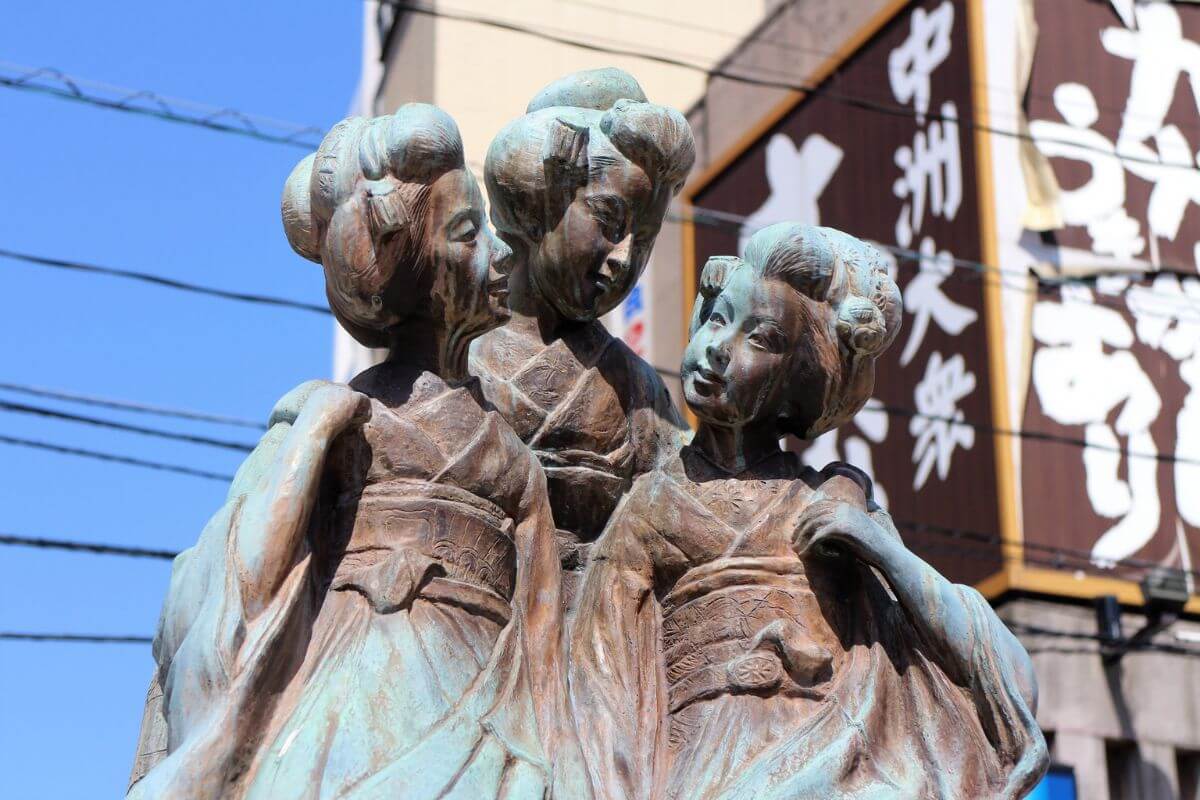
▲A bronze statue based on the Hakata doll “Three Maiko” that was exhibited at the Expo
At the 1925 Paris Exposition of Modern Decorative Arts and Crafts, Fukuoka Prefecture’s craftwork, Hakata dolls, won a silver medal and became known around the world as “Hakata dolls.”
At The Japan World Exposition, Osaka, 1970, the first world exposition in Asia, a pavilion called the Japanese Folk Crafts Museum was exhibited to promote folk craftworks. A variety of craftworks used in the daily lives of Japanese people, such as ceramics, dyed goods, and wood lacquerware, were exhibited.
World expositions and craftworks are inseparably linked, and they were a place where Japanese craftworks were brought into the spotlight. And at Expo 2025 Osaka, Kansai, many craftworks from all over the country will gather, providing a great opportunity for people from all over the world to learn about them. Let’s go on a journey to discover Japanese craftworks at the Expo!
A pavilion with a large Wajima lacquer globe
First, there is the pavilion “Earth at Night,” which is a must-visit for anyone interested in traditional crafts. The pavilion is located in the center of the Connecting Zone and no reservation is required for entry.
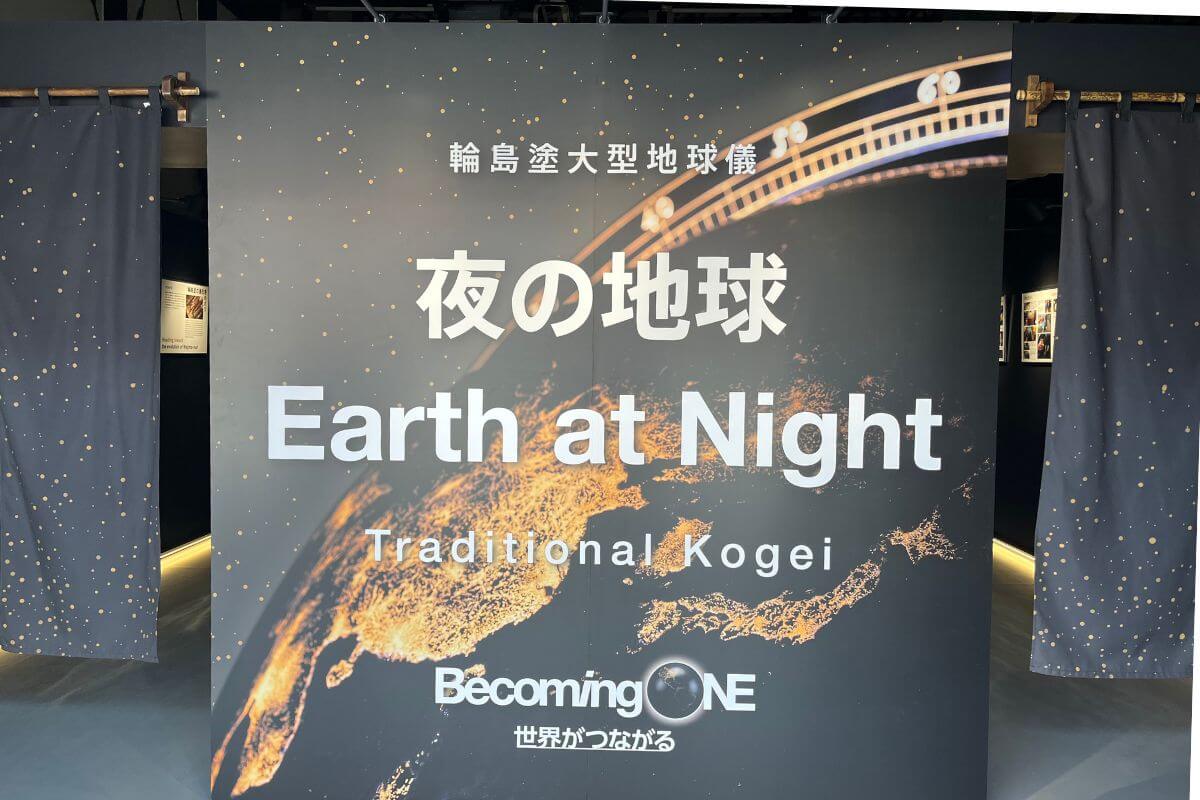
On display here is “Earth at Night,” a large globe made with Wajima lacquerware, a traditional craft from Wajima City, Ishikawa Prefecture. Wajima City, home of Wajima lacquerware, was hit by the Noto Peninsula earthquake that occurred on January 1, 2024. The large Wajima lacquerware globe was miraculously undamaged during the earthquake, and is therefore also on display as a “symbol of reconstruction.”
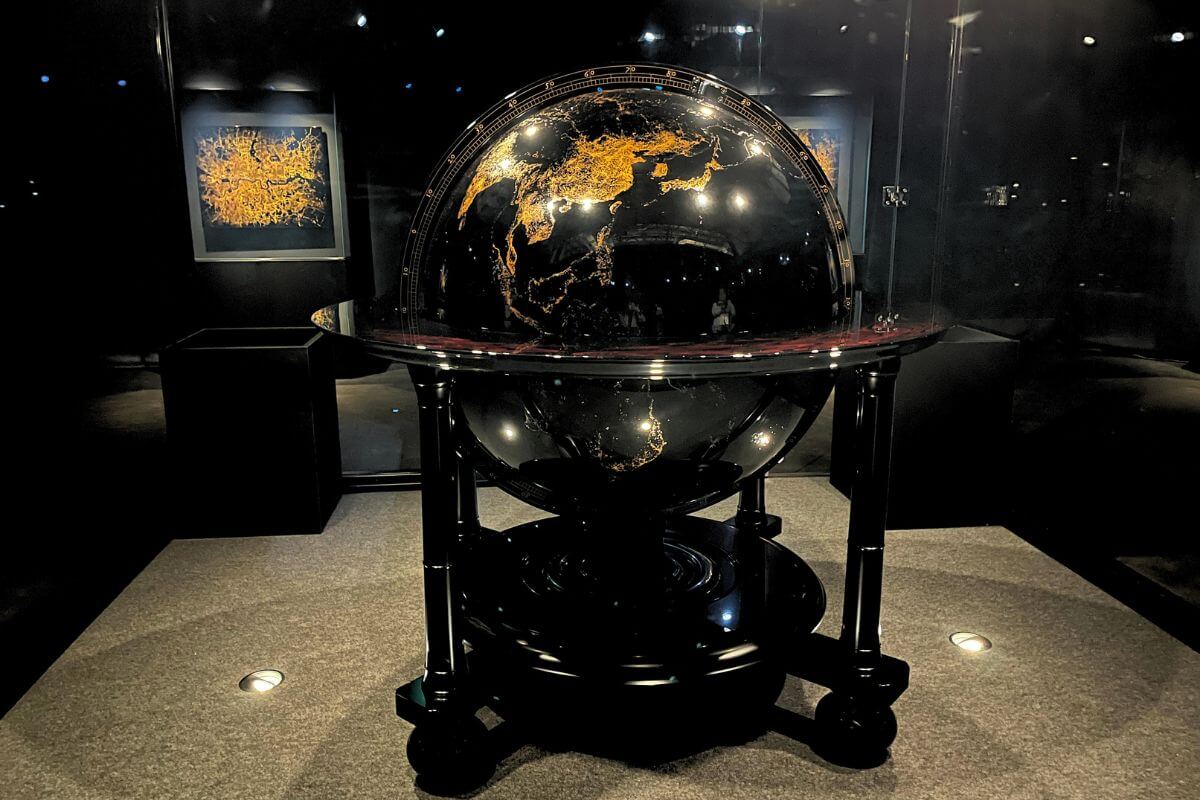
If you look closely, you’ll be surprised at its size, which is 1m in diameter. I’ve never seen a globe like this! The pavilion is dimly lit, so the beauty of the jet black and gold colors stands out. Why not try to find out where your country is?
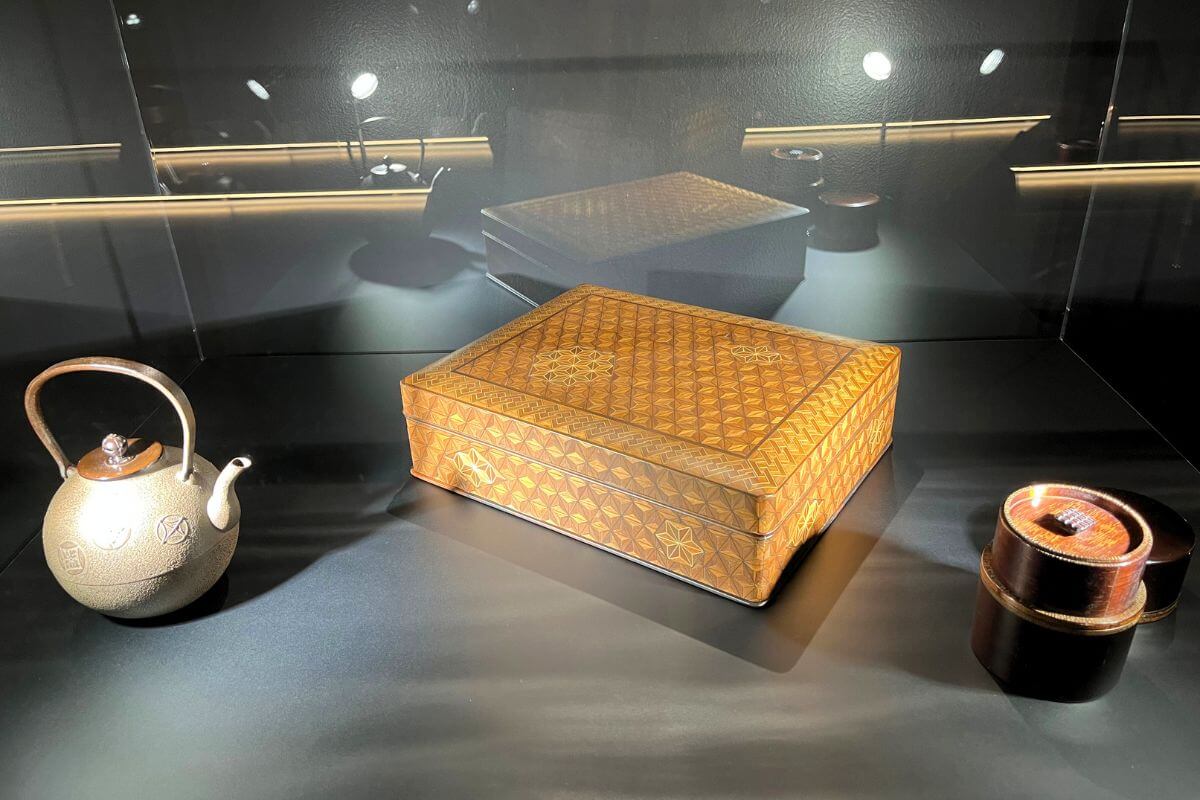
There is also an area where representative crafts from all over Japan, such as Nambu ironware and Hakone marquetry, are exhibited, so be sure to check them out as well.
Craft events are also held
Among the events held daily at the Expo site, there are some themed on traditional Japanese crafts. Kodawari Times went to the JAPAN CRAFT EXPO 2025, which was held from June 16th to 18th. This event is an experiential exhibition that brings together 20 craft production areas from around the country and three special projects. Let’s introduce some of the crafts we encountered there!
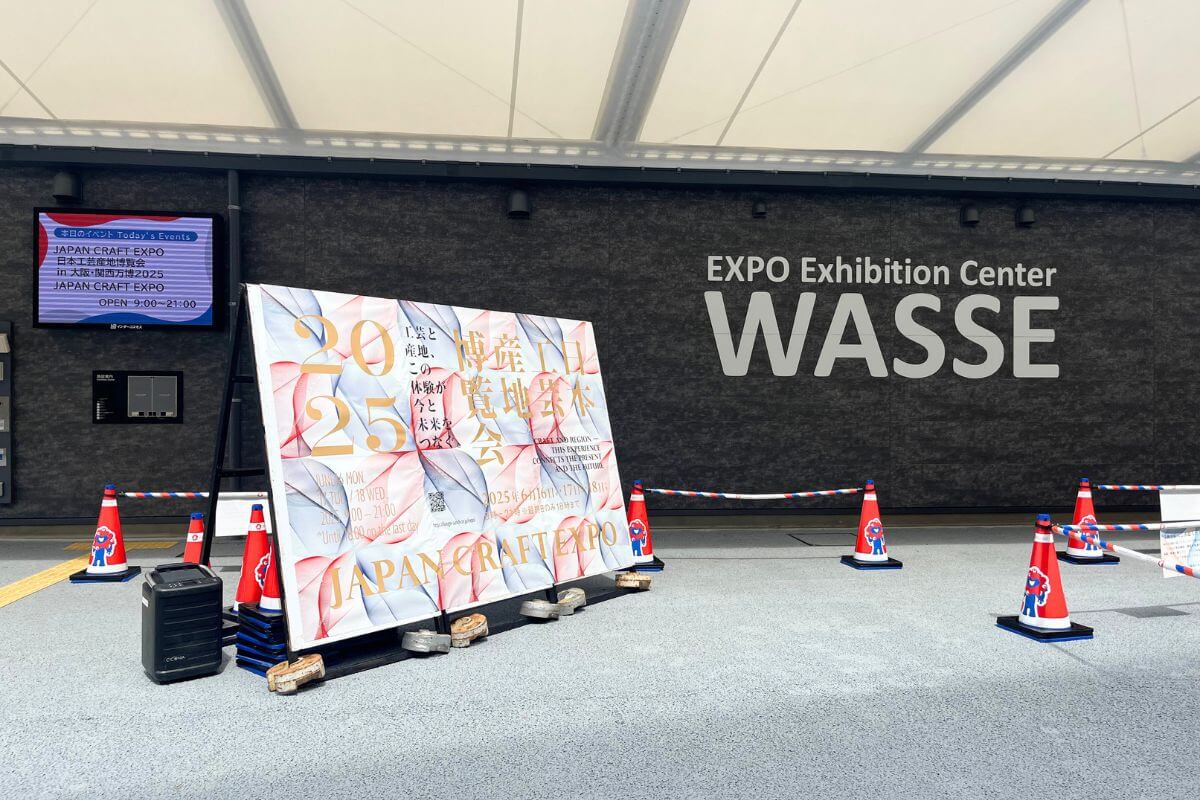
Sakai Cutlery / Sakai Ichimonji Mitsuhide
Sakai knives are one of Osaka’s most representative traditional crafts. Born in Sakai City, which has long flourished as a knife production area, Sakai knives have developed along with Osaka’s food culture. Today, they are loved by food professionals not only in Japan but all over the world.
Sakai Ichimonji Mitsuhide, which has been in business for 70 years in the Doguyasuji Shopping Arcade in Namba, Osaka, is a specialty store that handles over 2,000 types of knives, including Japanese knives, Western knives, and household knives.
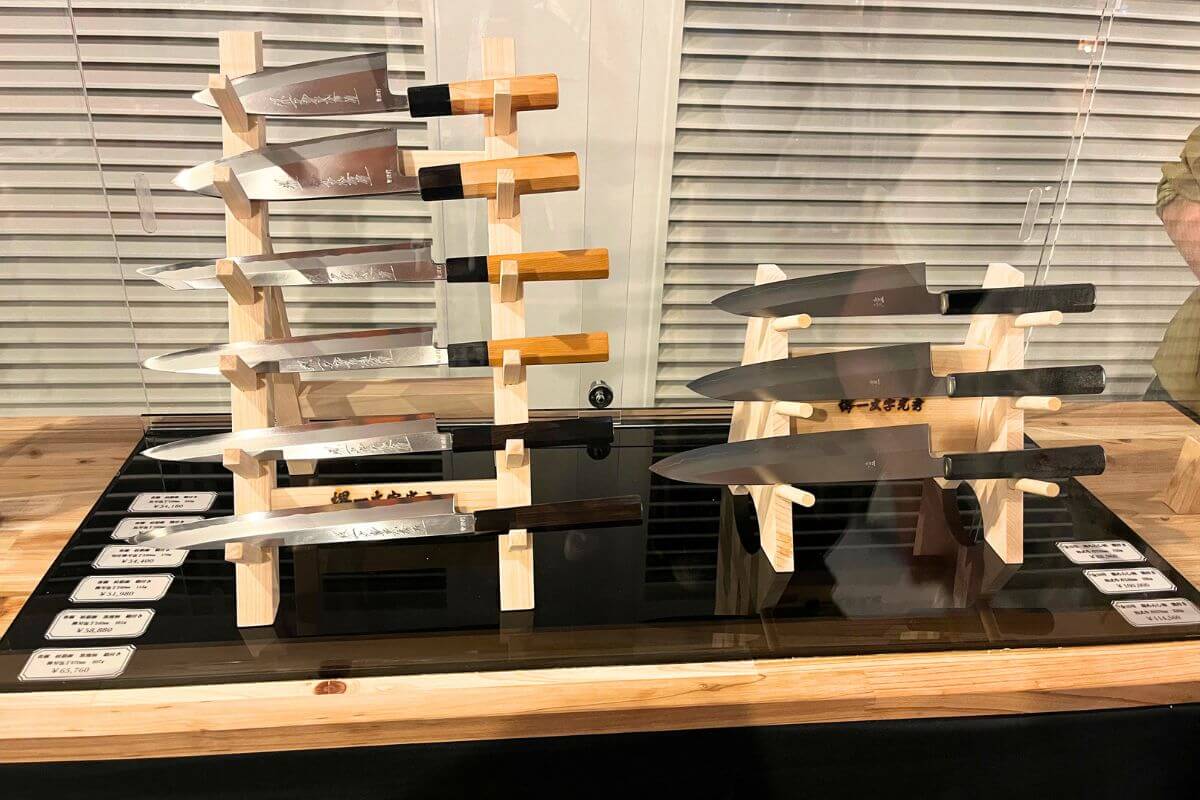
Sakai knives are sharp, single-edged knives that can smoothly cut ingredients without compromising their appearance or flavor.
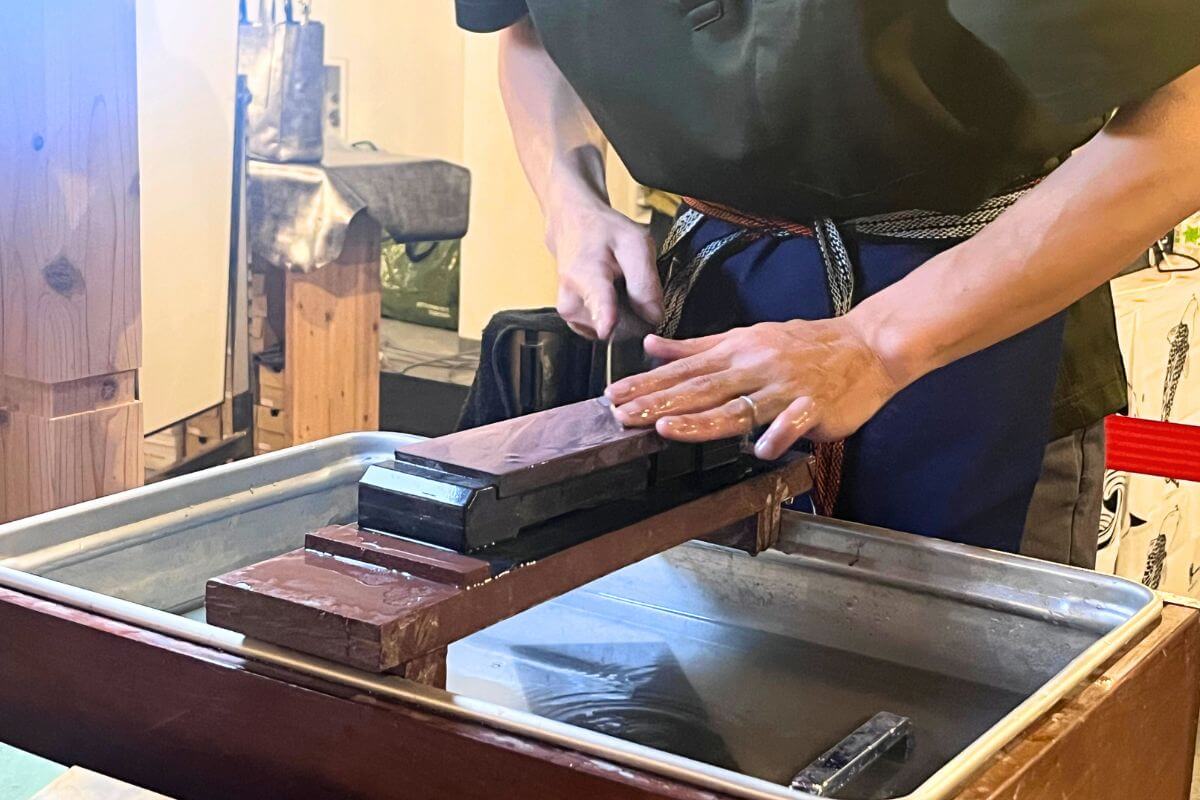
At the booth, there was also a demonstration of knife sharpening. The stones used to sharpen knives are called whetstones, and they start with the rough ones and then finish with a smooth, fine whetstone.
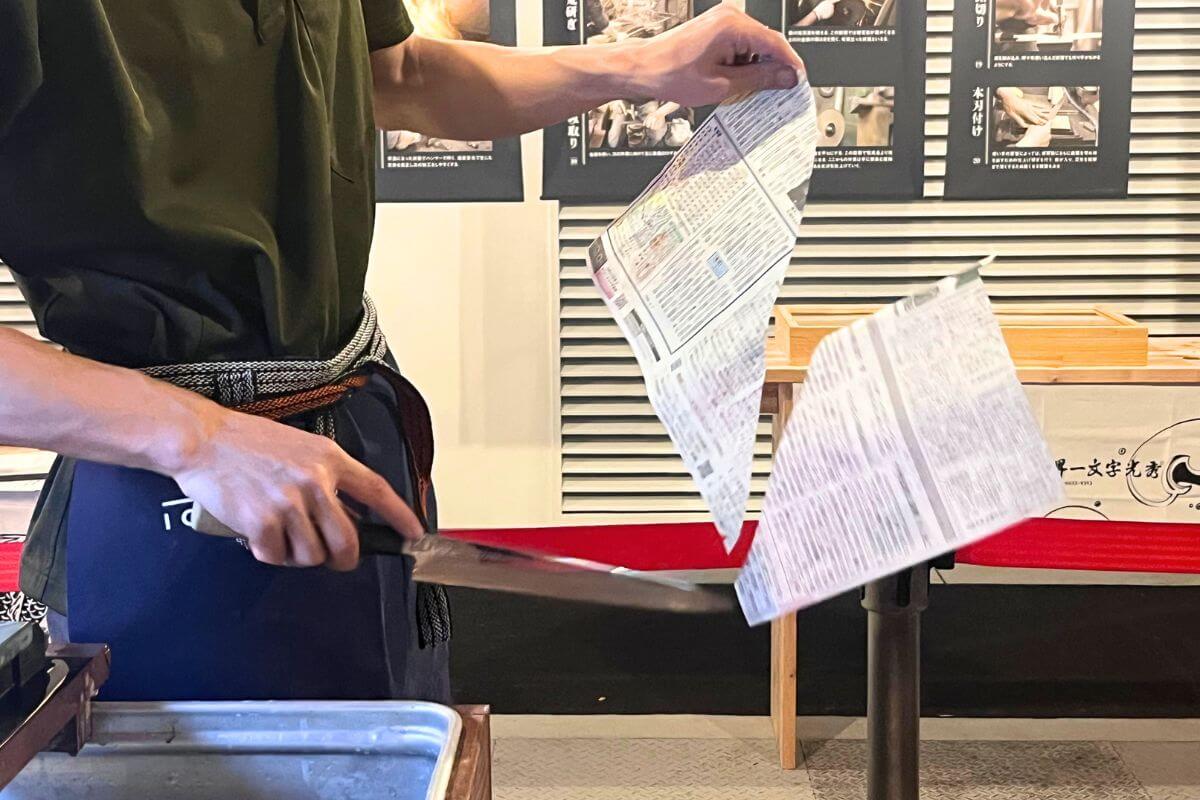
If you carefully sharpen a dull knife with a whetstone, it will be able to cut through a thin newspaper like this! It has a very satisfying sharpness. At the Sakai Ichimonji Mitsuhide physical store, they not only help you choose a knife, but also provide maintenance and repair services such as knife sharpening, so it’s a great place to find a knife that you can use for a long time.
Official website: https://global.ichimonji.co.jp/
Wajima Lacquerware / Taya Shikkiten
Among the Wajima lacquerware brands featured on the large globe “Earth at Night,” representative brands were also on display. Taya Shikkiten, located in Wajima City, Ishikawa Prefecture, is a brand that has been involved in Wajima lacquerware since the Edo period, about 200 years ago, and is involved in the production, sale, and repair of lacquerware.
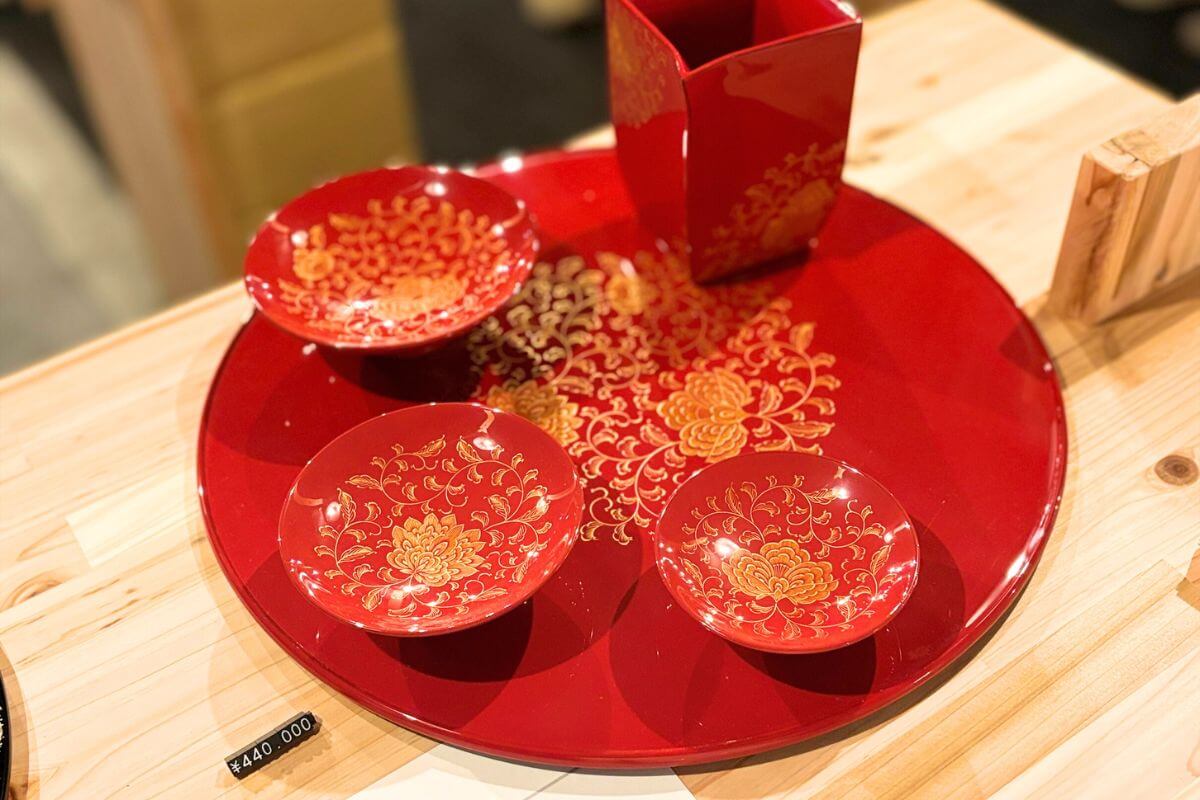
The appeal of Wajima lacquerware is that it is light, durable, and pleasant to the touch, and is finished with gorgeous designs using techniques such as maki-e and chinkin. It can be used not only for special occasions such as celebrations, but also as tableware for everyday use to add a touch of class to your dining table.
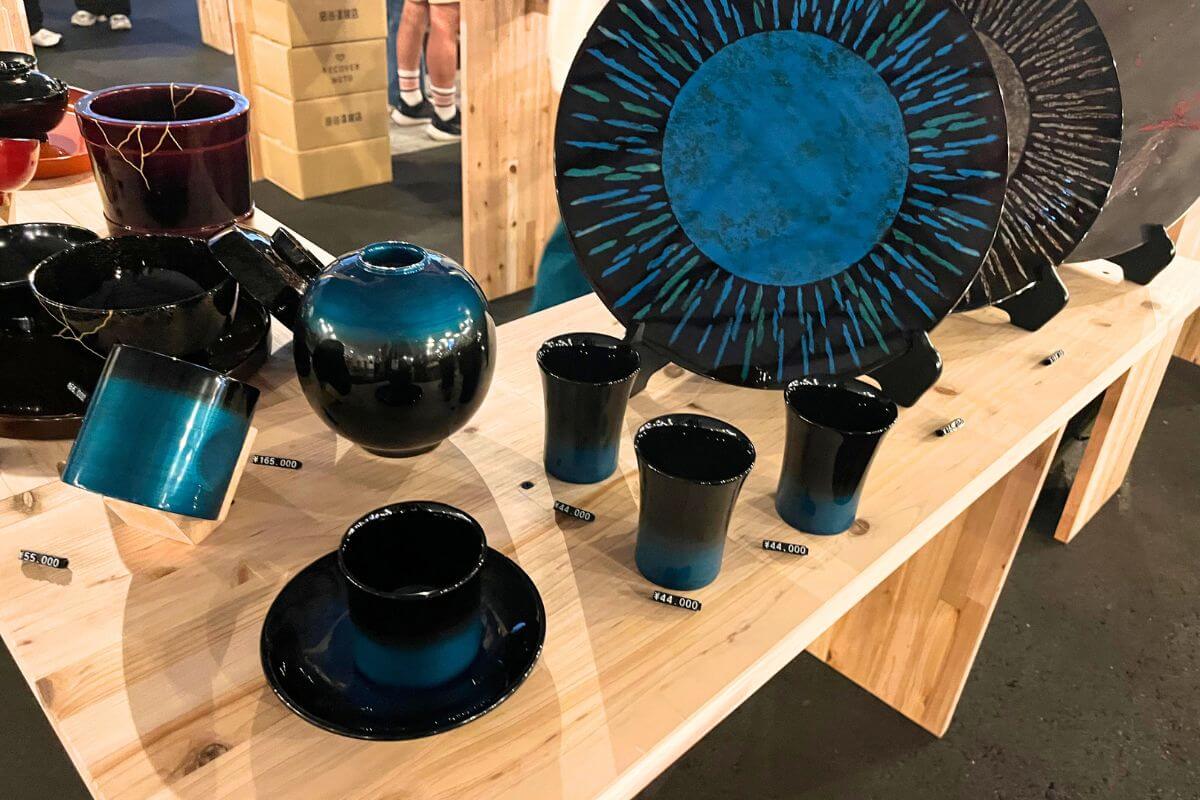
The coffee cup with a beautiful black and blue gradation in the foreground of this photo is a work that attracted attention as a gift from former Prime Minister Fumio Kishida to the 46th President of the United States, Joe Biden, in 2024. It is a great product because the outside does not heat up even when hot coffee is poured into it, and cold drinks do not condense. It seems that it can also be engraved with a name by a lacquer artist!

Other than that, the containers with typically Japanese designs are also very cool! You can fully enjoy the splendor of Wajima lacquerware.
Taya Shikkiten not only sells Wajima lacquerware, but also operates a restaurant in Kanazawa City, Ishikawa Prefecture that uses the lacquerware, so be sure to visit the store and enjoy Wajima lacquerware.
Official website: https://www.wajimanuri.co.jp/e_tayashikkiten/
Bamboo chopsticks / Yamachiku
A chopstick manufacturer that continues to make only bamboo chopsticks in Kumamoto Prefecture, Kyushu. Chopsticks are an essential part of the Japanese dining table, and are a popular souvenir for foreign tourists. For over half a century, Yamachiku has been committed to making chopsticks from 100% domestically produced natural bamboo, carefully crafting each and every pair.
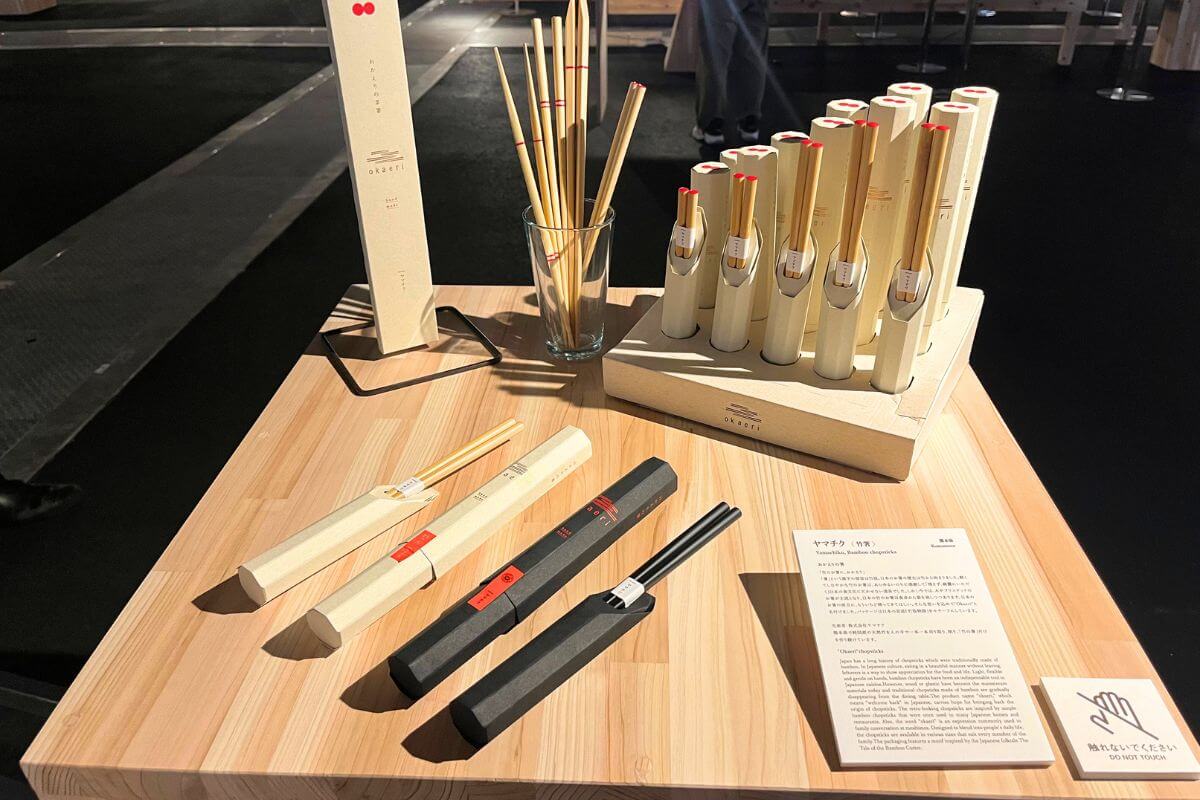

The best thing about this shop is that you can choose the chopsticks that suit you best from over 300 different types, with different shapes, colors, and lengths.
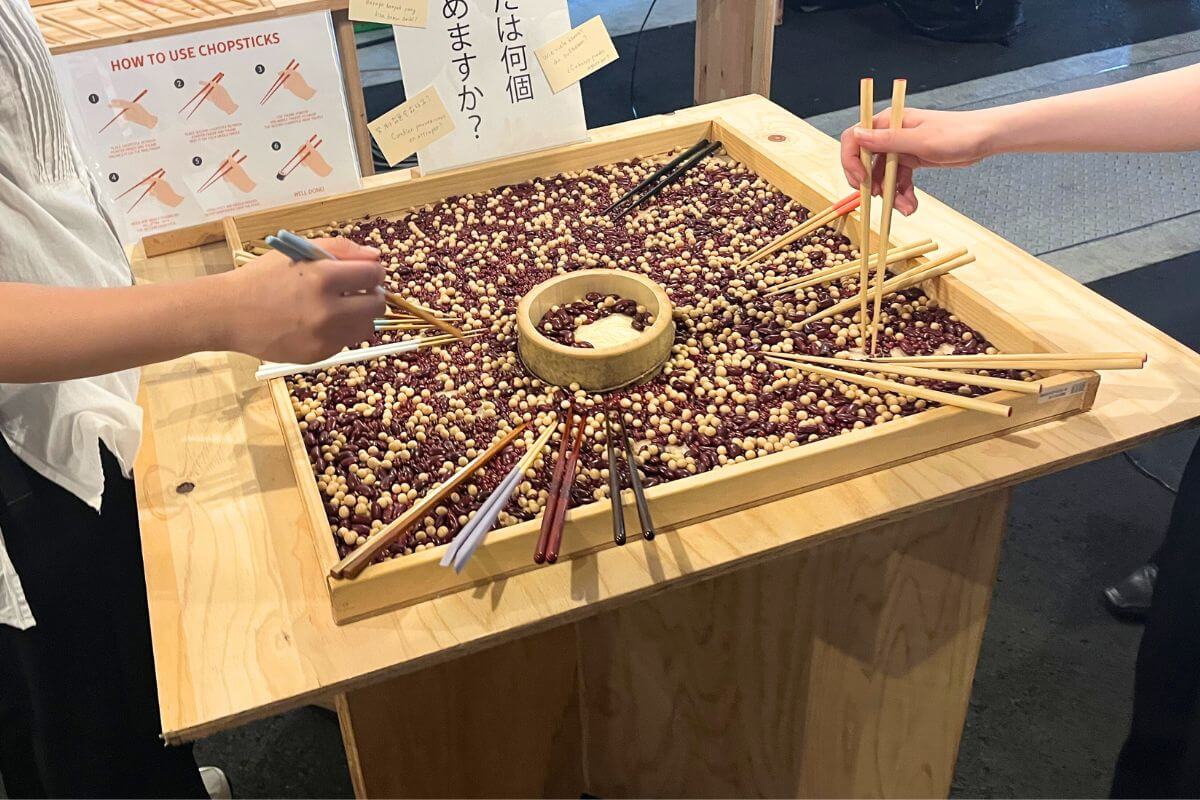
There was a corner set up where you could try out different chopsticks to see how they felt to use, so I gave it a try. I was surprised at how easy it was to pick up beans depending on which chopsticks I used! It seems that the key to finding the right chopsticks for you is to actually try them out.

Other recommended chopsticks include the “Ura Waza Chopsticks” designed to hold the lid of a cup ramen, and the “Saibashi for Nimono – Nimono Meijin” chopsticks that can also be used as bamboo skewers! Yamachiku’s bamboo chopsticks, which are used every day for meals, are sure to be a welcome souvenir from Japan.
Official website: https://hashi.co.jp/
Glass / Sugahara Glassworks, Sghr
Sugahara Glassworks is a manufacturer of glass products in Kujukuri, known for having one of the largest sandy beaches in Japan. Since its founding in 1932, the company has been committed to producing handmade glass and has an astonishing lineup of over 4,000 types of glass.

Many of the products are developed and designed by the glass craftsmen themselves! The charm of these products is that they make the most of the beauty and individuality of glass, something only a craftsman with deep knowledge of glass can achieve.
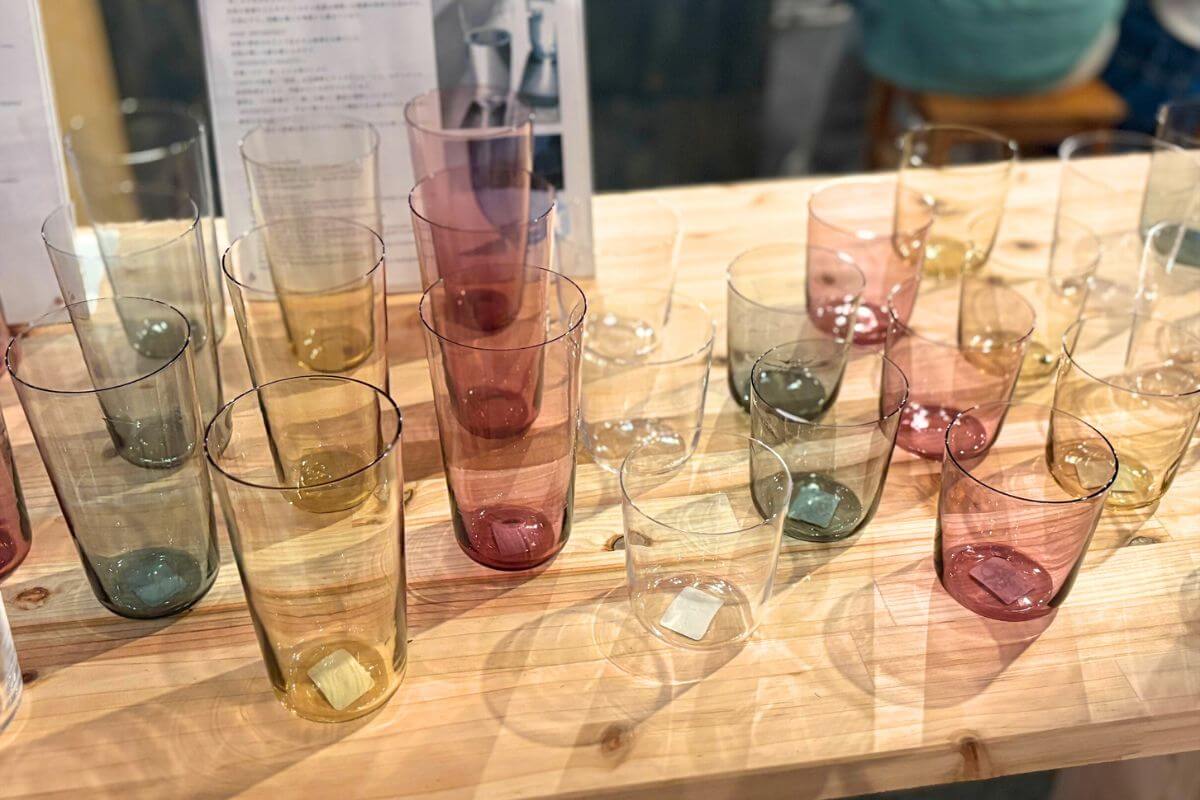
This “Sghr RECYCLE” is recycled glass made from recycled glass scraps. The glass scraps are a mixture of colors and impurities, and the interesting thing about them is that you never know what color the finished glass will be until you try making it. Why not find your favorite glass from among the unique pieces?
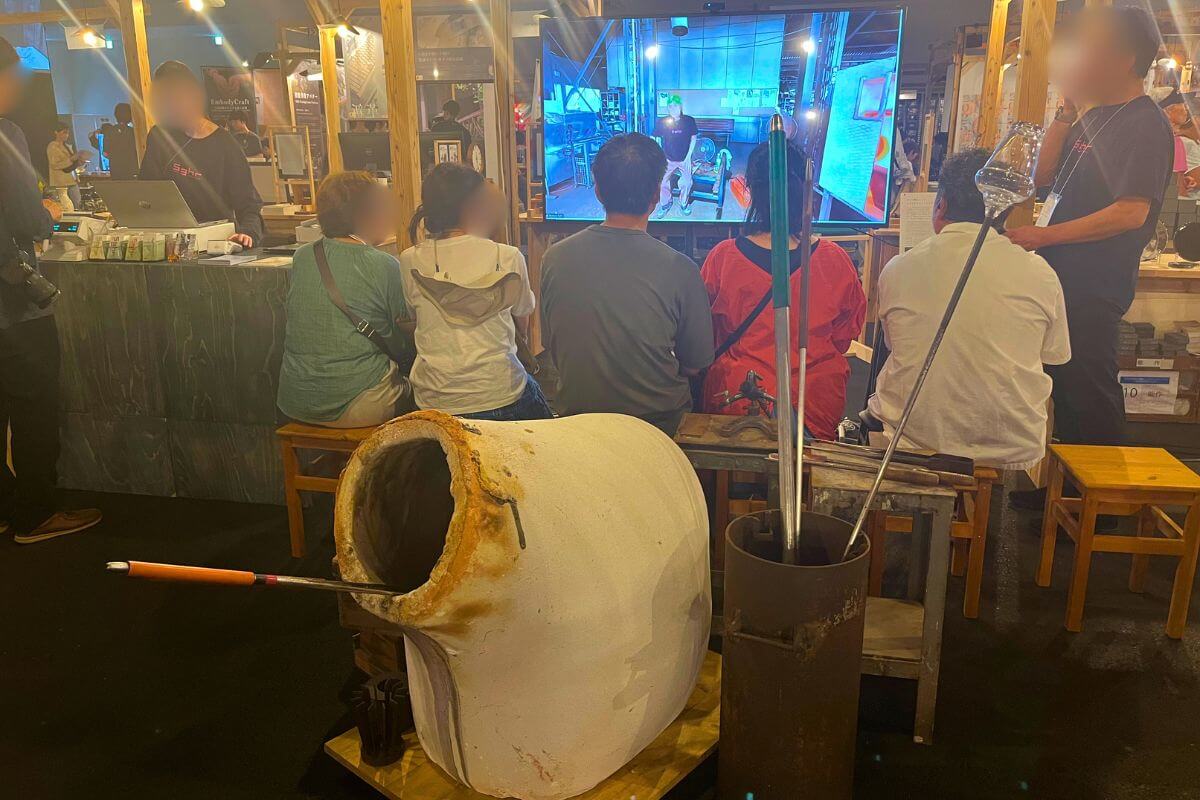
There was also a live broadcast between the exhibition booth and the Kujukuri workshop, allowing people to see how glass is made. At the workshop, you can actually try your hand at glass making, so be sure to visit Sugahara Glassworks in Kujukuri.
Official website: https://www.sugahara.com/
Tatara Ironworks / Tanabe Tatara no Sato
“Tatara Ironworks” has a 600-year-old tradition in the Okuizumo region of Shimane Prefecture. It is an ancient Japanese ironmaking method in which iron is made using iron sand and charcoal in a furnace built from clay. Okuizumo is the only area in the world where the tatara flames are still preserved.

Speaking of tatara, it is the Japanese sword. The finest steel produced is called “tamahagane” and was used as the raw material for the Japanese swords worn by Japanese samurai and warriors.
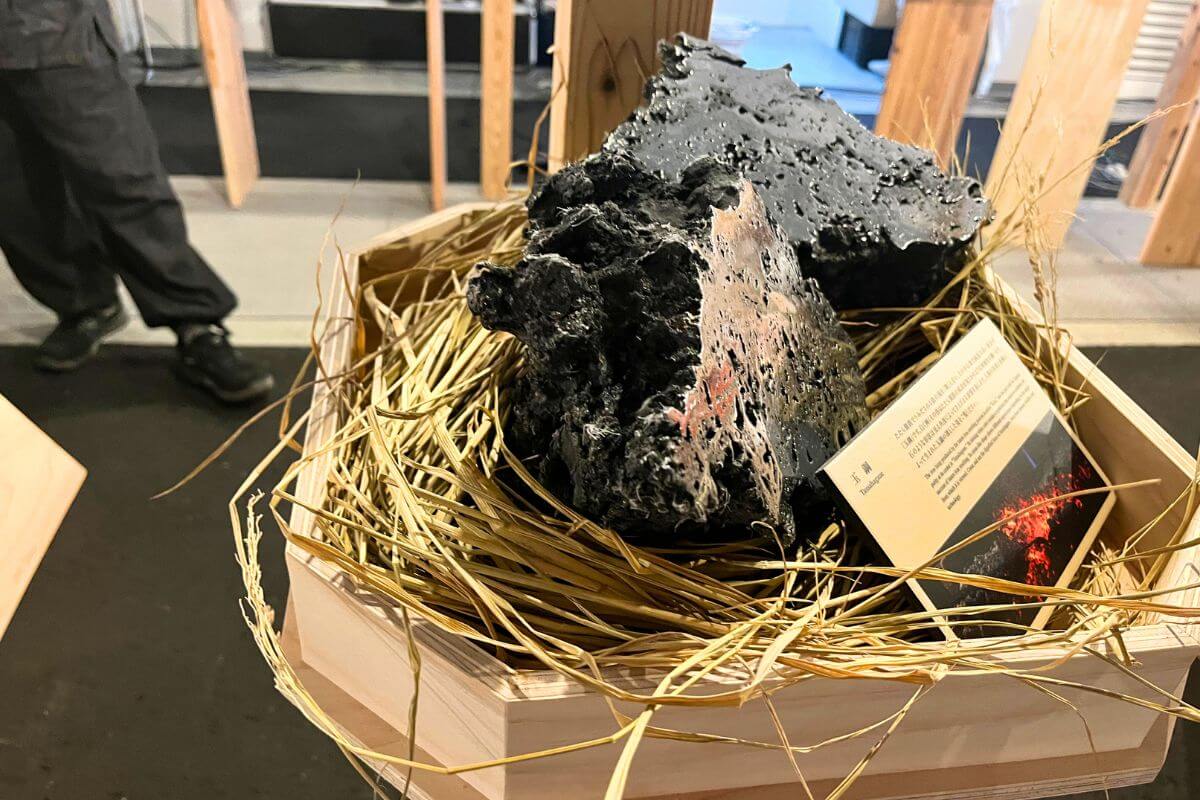
▲Tamahagane, the raw material for Japanese swords
Just like a Japanese sword, these knives (top two in the photo) are made by repeatedly heating and hammering steel, folding it over and over again, and hammering it again. They have the beauty of a Japanese sword and exceptional sharpness.
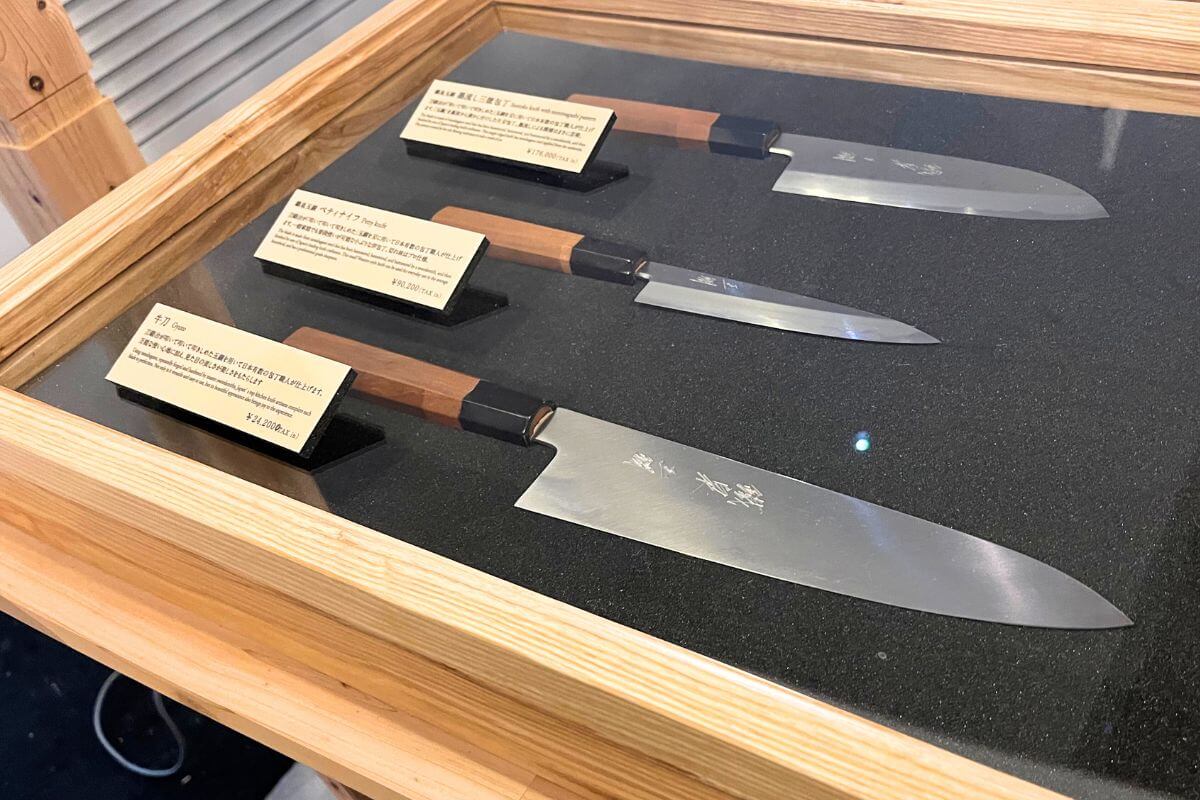
Other products made from tamahagane include an iron kettle that combines Shimane’s tatara ironmaking techniques with the traditional beauty of Iwate’s Nambu ironware, as well as modern sake cups.
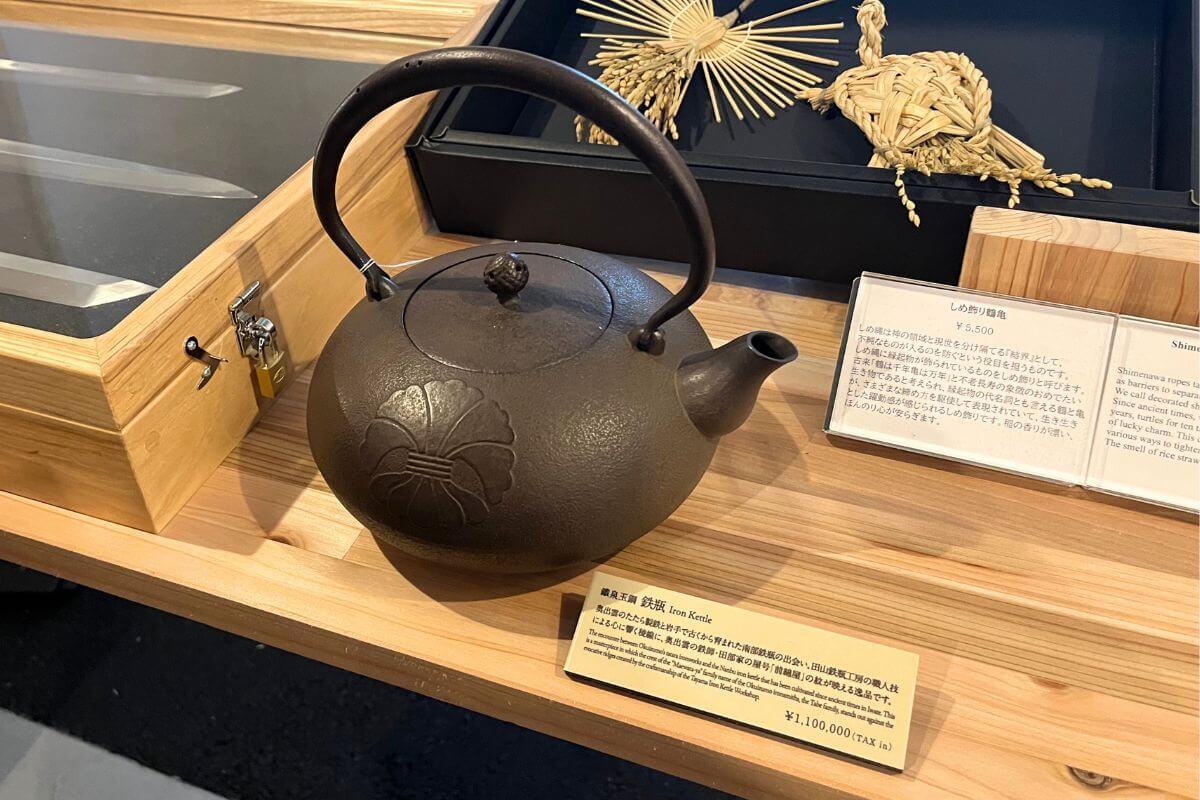

Tanabe Tatara no Sato has opened a specialty store called “Okuizumomaewataya Tessen-do” in Yoshida-cho, Unnan City, Shimane Prefecture, where you can learn about the history of tatara ironmaking, so be sure to come and see the one-of-a-kind works made from tamahagane up close.
Official website: https://tanabetataranosato.com/tatara/tessen-tatara/
MYAKU-MYAKU Crafts/Nakagawa Masashichi Shop
Finally, we will introduce Nakagawa Masashichi Shoten in Nara Prefecture. Founded in 1716 as a linen textile business, the brand has a history of exhibiting linen handkerchiefs at the Paris World Exposition in 1925. Currently, the company deals in lifestyle goods centered around Japanese crafts, and has around 60 stores across Japan.
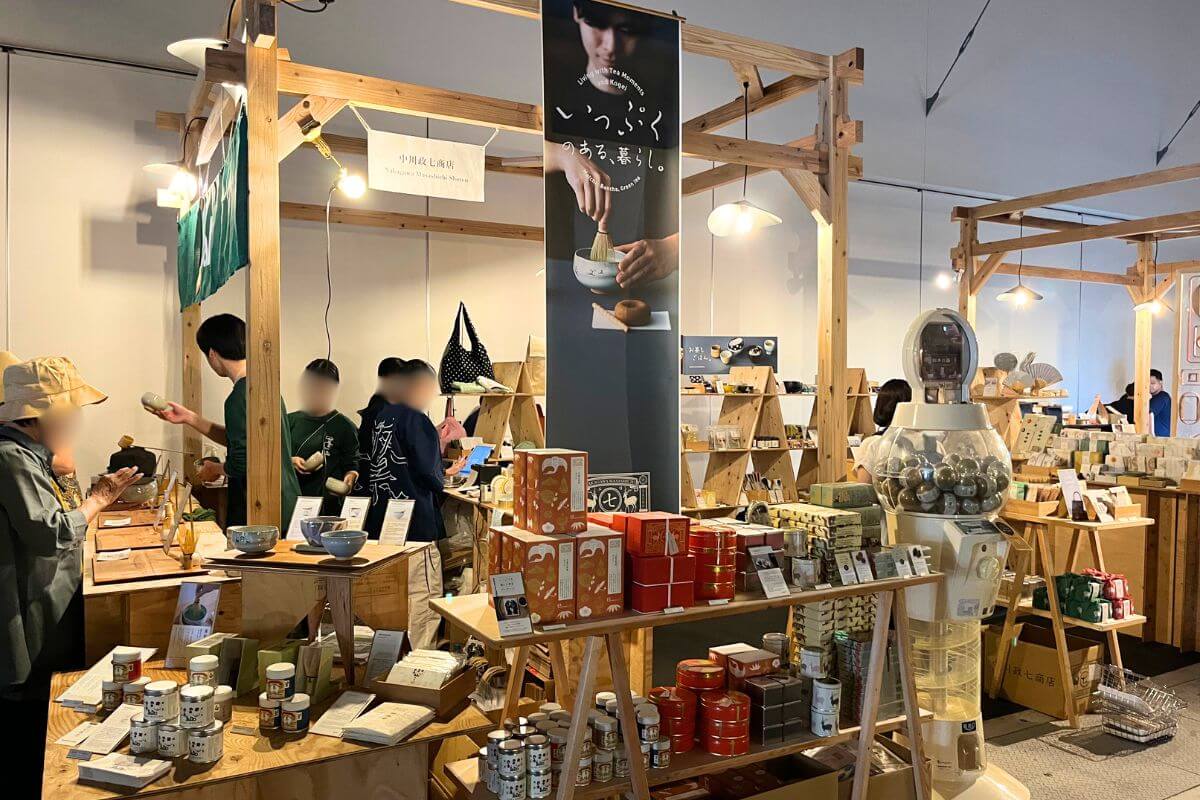
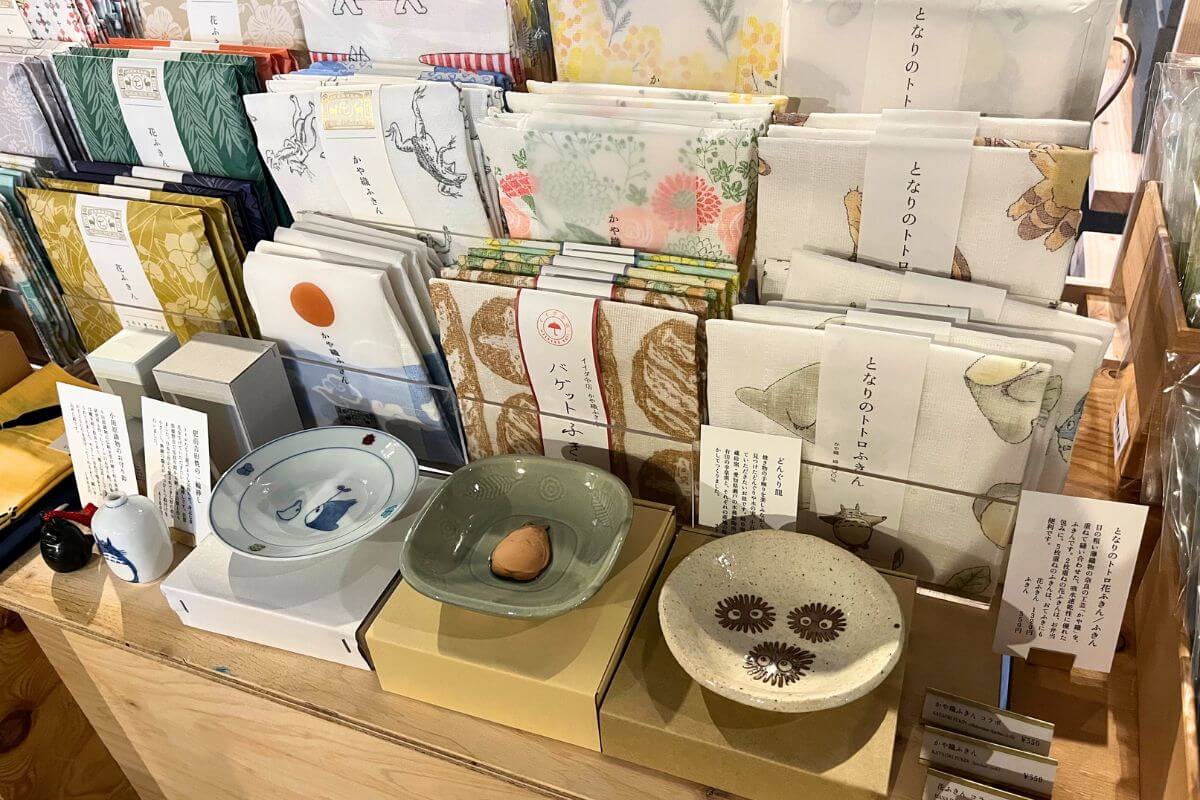
The booths are laid out like small shops and sell not only miscellaneous items like tableware and dishcloths, but also food items like tea and sweets, making them a very interesting sight.
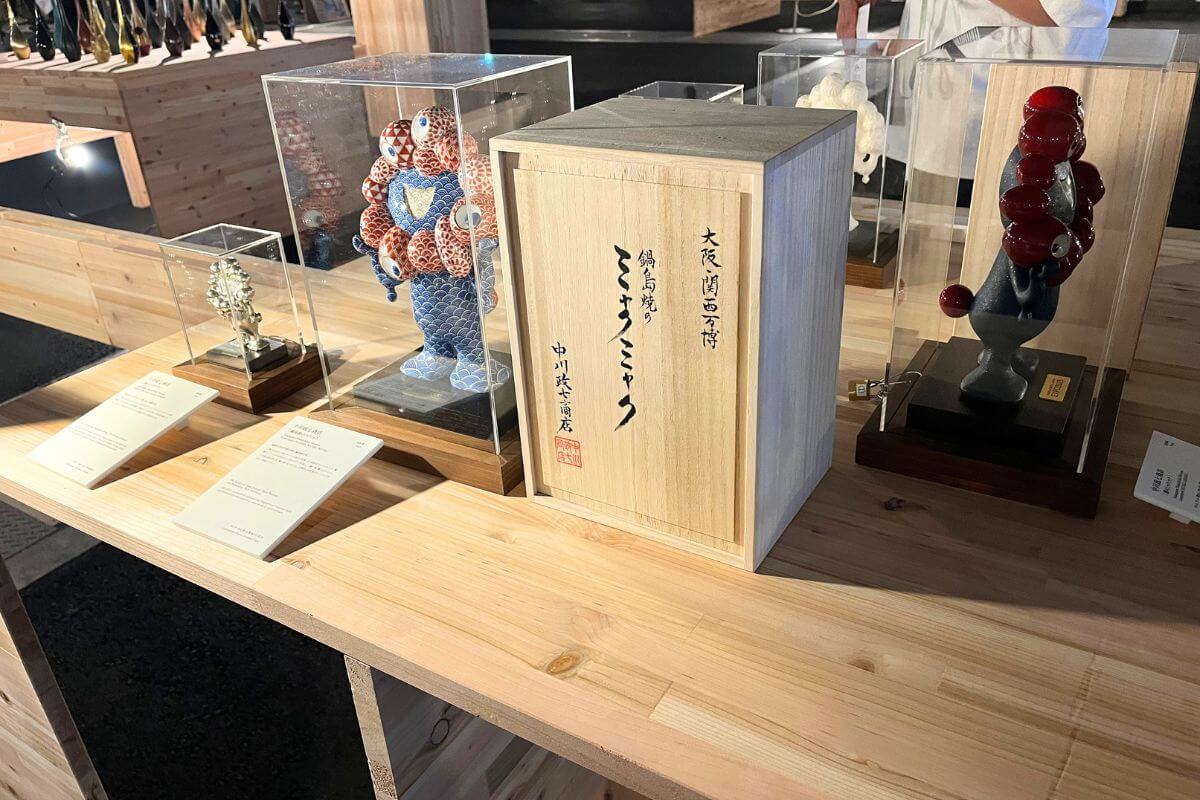
The highlight is the MYAKU-MYAKU crafts. They are works filled with the spirit of the Expo, made from materials from all over Japan, such as lacquer, tin, handmade washi paper, and glass. These are officially licensed products of the 2025 Osaka-Kansai Expo, and are on sale at the official shop “KINTETSU” inside the venue. (Reservations and lottery sales have ended.)
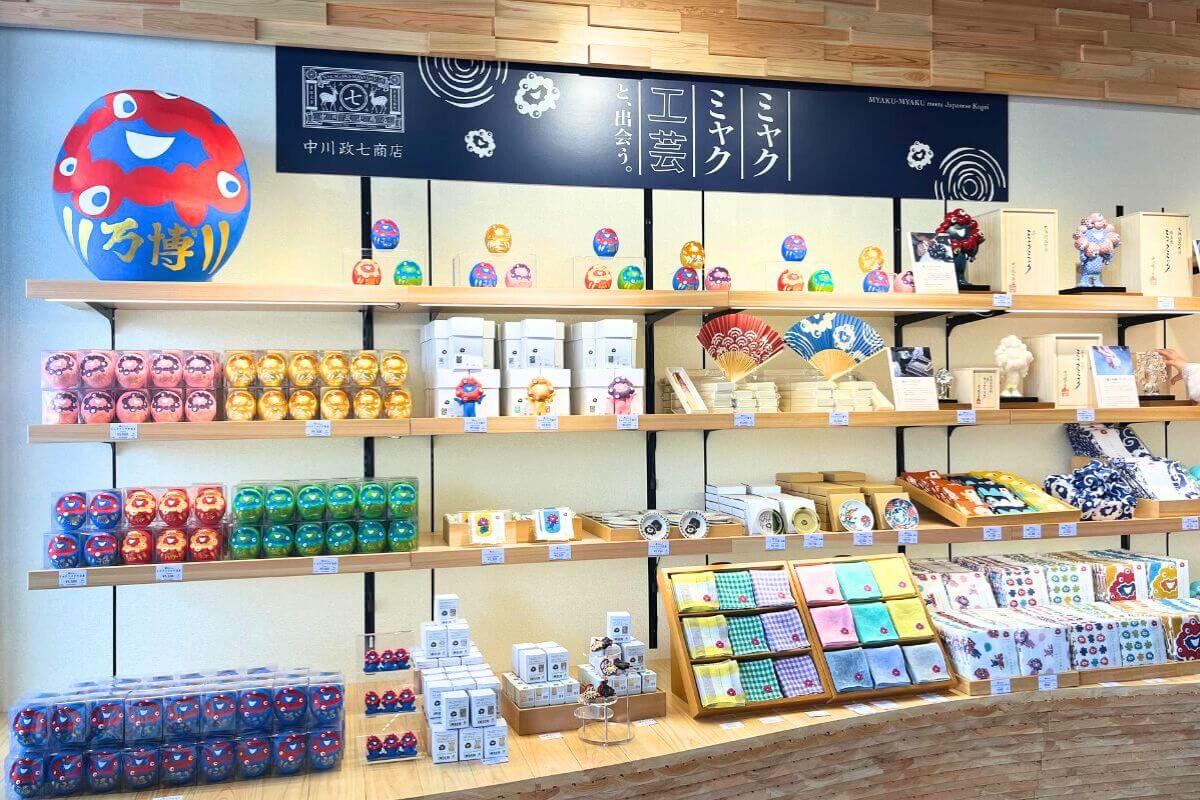
Other popular items include Daruma dolls, small plates, folding fans, and other crafts exclusive to the Expo, all made in collaboration with MYAKU-MYAKU. Be sure to check out the official shop inside the Expo site.
▼Click here for an article introducing the official shop inside the Expo site
Official website: https://www.nakagawa-masashichi.jp/company/
▼For more information on Nakagawa Masashichi Shoten, please see here
Upcoming craft events
At the Expo 2025 Osaka, Kansai, there will be more events planned where you can see, touch, and experience Japanese crafts. Here is an introduction to the main schedule.
・DISCOVER KOUGEI in EXPO2025 (42nd National Convention of the Traditional Crafts Month)
An exhibition, demonstration, and experience event that brings together traditional crafts from Kansai and across the country. It’s a rare opportunity to experience making traditional crafts such as Tsugaru lacquerware and Kyo Kumihimo within the expo.
KOUGEI SHOWCASE Exhibition and Demonstration
[Date] August 5th (Tue), August 6th (Wed), 2025
[Location] TEAM EXPO Pavilion (inside Future Life Village)
TEWAZA LIVE Experience and Demonstration
[Date] August 22nd (Fri), August 23rd (Sat), August 24th (Sun), 2025
[Location] Gallery EAST
Official website: https://kougei-expo.com/discover-kougei/
Discover Japanese crafts at the Osaka Kansai Expo!
Expos have played an active role as a platform for showcasing Japanese craftsmanship and crafts to the world. This year’s Osaka-Kansai Expo will also bring together many high-quality crafts from all over Japan.
There is no other international event that brings together so many of them in one place, so if you’re interested in Japanese crafts, be sure to visit the Expo site! You can encounter Japanese crafts at pavilions, craft events, official stores, and more. And if you find a craft you like, we recommend visiting the craft’s production area and taking a look at the origins of craftsmanship.




